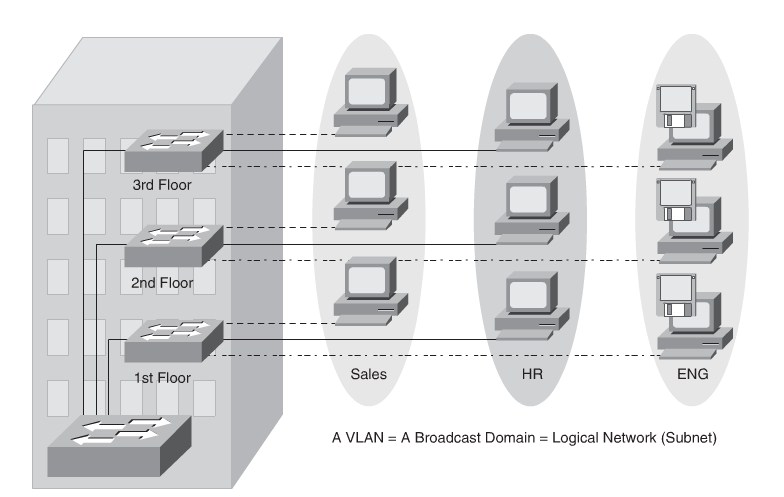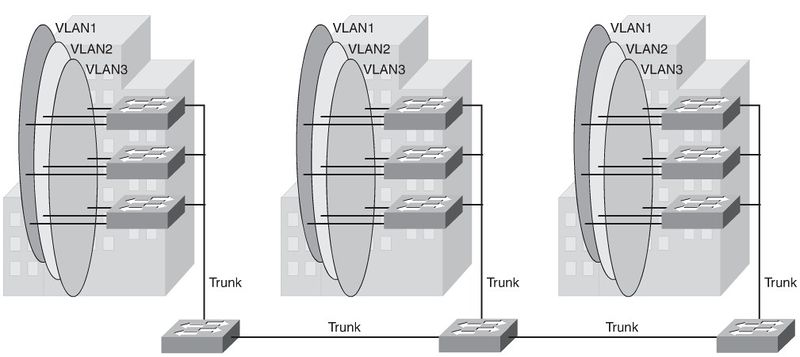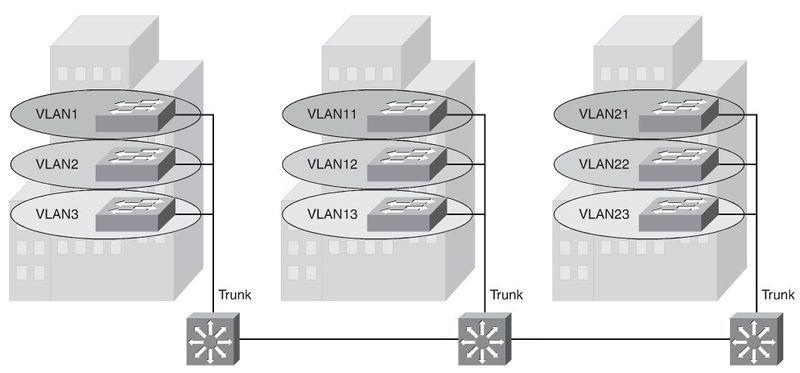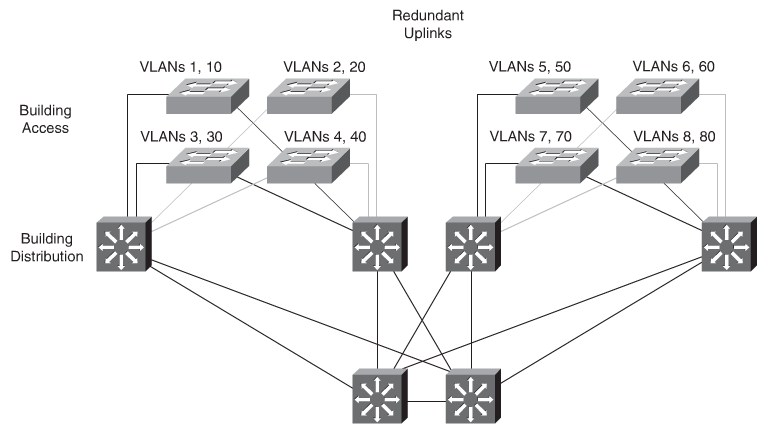Difference between revisions of "CCNP SWITCH/Implementing VLANs in Campus Networks"
m |
m (→Comparison of End-to-End VLANs and Local VLANs) |
||
| Line 37: | Line 37: | ||
switches. | switches. | ||
==Comparison of End-to-End VLANs and Local VLANs== | ==Comparison of End-to-End VLANs and Local VLANs== | ||
| + | ===Reasons for using End-To-End VLANs=== | ||
*'''Grouping users''':Users can be grouped on a common IP segment, even though they | *'''Grouping users''':Users can be grouped on a common IP segment, even though they | ||
are geographically dispersed. Recently the trend has been moving toward virtualiza- | are geographically dispersed. Recently the trend has been moving toward virtualiza- | ||
| Line 47: | Line 48: | ||
resources on their VLAN without their traffic being routed off the VLAN, even | resources on their VLAN without their traffic being routed off the VLAN, even | ||
though the traffic might traverse multiple switches. | though the traffic might traverse multiple switches. | ||
| + | *'''Special purpose VLAN''':Sometimes a VLAN is provisioned to carry a single type of | ||
| + | traffic that must be dispersed throughout the campus (for example, multicast, voice, | ||
| + | or visitor VLANs). | ||
| + | *'''Poor design''':For no clear purpose, users are placed in VLANs that span the campus | ||
| + | or even span WANs. Sometimes when a network is already configured and running, | ||
| + | organizations are hesitant to improvethe design because of downtime or other politi- | ||
| + | cal reasons. | ||
| + | *Finally, troubleshooting devices on a campus with end-to-end VLANs can be chal- | ||
| + | lenging because the traffic for a single VLAN can traverse multiple switches in a large | ||
| + | area of the campus, and that can easily cause potential spanning-tree problems. | ||
| + | ==Mapping VLANs to a Hierarchical Network== | ||
| + | In the past, network designers have attempted to implement the 80/20 rule when design- | ||
| + | ing networks. Today it is reversed to 20/80 because most traffic will end in the Data Center.<br/><br/> | ||
| + | End-To-End VLANs was attractive when IP addresses were manually administered. Today most networks use DHCP.<br/> | ||
| + | In addition, because STP is configured for redun- | ||
| + | dancy, the switch limits the STP to only the access and distribution switches that help to | ||
| + | reduce the network complexity in times of failure.<br/><br/> | ||
| + | Implementing the enterprise campus architecture design using local VLANs provides the | ||
| + | following benefits: | ||
| + | *'''Deterministic traffic flow''':The simple layout provides a predictable Layer 2 and | ||
| + | Layer 3 traffic path. | ||
| + | *'''Active redundant paths''':When implementing Per VLAN Spanning Tree (PVST) or | ||
| + | Multiple Spanning Tree Protocol (MSTP) because there is no loop, all links can be | ||
| + | used to make use of the redundant paths. | ||
| + | *'''Finite failure domain''':If VLANs are local to a switch block, and the number of | ||
| + | devices on each VLAN is kept small, failures at Layer 2 are confined to a small | ||
| + | subset of users. | ||
| + | *'''Scalable design''':Following the enterprise campus architecture design, new access switches can be easily incorporated, and new submodules can be added when necessary. | ||
| + | {| | ||
| + | |[[Image:ScreenShot1077.jpg|800px|left|thumb|VLAN Implementation]] | ||
| + | |} | ||
| + | ==Best Practices for VLAN Design== | ||
| + | *For the Local VLANs model, it is usually recommended to have only one to three VLANs per access module | ||
| + | *Avoid using VLAN 1 as the “blackhole” for all unused ports.* | ||
| + | *Try to always have separate voice VLANs, data VLANs, management VLANs, native | ||
| + | VLANs, blackhole VLANs, and default VLANs (VLAN 1). | ||
| + | *In the local VLANs model, avoid VTP. | ||
| + | *For trunk ports, turn off DTP and configure it manually. Use IEEE 802.1Q rather | ||
| + | than ISL | ||
| + | *Manually configure access ports. | ||
| + | *Prevent all data traffic from VLAN 1; only permit control protocols to run on VLAN | ||
| + | 1 (DTP, VTP, STP BPDUs, PAgP, LACP, CDP, and such.) | ||
| + | *Avoid using Telnet because of security risks; enable SSH support on management | ||
| + | VLANs. | ||
| + | ==Configuring VLANs== | ||
| + | Cisco Catalyst switches support up to 4096 VLANs depending on the platform and soft- | ||
| + | ware version. See [http://www.cisco.com/en/US/prod/switches/ps5718/ps708/networking_solutions_products_genericcontent0900aecd805f0955.pdf Cisco Catalyst Switch Guide]<br/> | ||
| + | {| class="wikitable sortable" style="text-align:center" border=1 | ||
| + | |+ VLAN Ranges | ||
| + | |- bgcolor=lightgrey | ||
| + | ! VLAN Range !! Range !! Usage !! Propagated via VTP | ||
| + | |- | ||
| + | | 0, 4095 || Reserved || For system use only. You cannot see or use these VLANs. || - | ||
| + | |- | ||
| + | | 1 || Normal || Cisco default. You can use this VLAN, but you cannot delete || Yes | ||
| + | |- | ||
| + | | 2-1001 || Normal || For Ethernet VLANs. You can create, use, and delete these VLANs. || Yes | ||
| + | |- | ||
| + | | 1002–1005 || Normal || Cisco defaults for FDDI and Token Ring. You cannot delete VLANs 1002–1005. || Yes | ||
| + | |- | ||
| + | | 1006–1024 || Reserved || For system use only. You cannot see or use these VLANS. || - | ||
| + | |- | ||
| + | | 1025–4094 || Extended || For Ethernet VLANs only. || Not supported in VTP versions 1 and 2. The switch must be in VTP transparent mode to configure extended- range VLANS. Only supported in version 3. | ||
| + | |} | ||
| + | <source lang="cli"> | ||
| + | Switch#<input>show vlan brief</input> | ||
| + | |||
| + | VLAN Name Status Ports | ||
| + | ---- -------------------------------- --------- ------------------------------- | ||
| + | 1 default active Fa0/1 | ||
| + | 100 VLAN0100 active Fa0/2, Fa0/3, Fa0/4, Fa0/5, Fa0/6, Fa0/7, Fa0/8, Fa0/9, Fa0/10 | ||
| + | Fa0/11, Fa0/12, Fa0/13, Fa0/14, Fa0/15, Fa0/16, Fa0/17, Fa0/18 | ||
| + | Fa0/19, Fa0/20, Fa0/21, Fa0/22, Fa0/23, Fa0/24 | ||
| + | 200 VLAN0200 active | ||
| + | 300 VLAN0300 active | ||
| + | 1002 fddi-default act/unsup | ||
| + | 1003 trcrf-default act/unsup | ||
| + | 1004 fddinet-default act/unsup | ||
| + | 1005 trbrf-default act/unsup | ||
| + | </source> | ||
| + | ===Configure VLANs=== | ||
| + | <source lang="cli"> | ||
| + | Switch# <input>configure terminal</input> | ||
| + | Switch(config)# <input>vlan 5</input> | ||
| + | Switch(config-vlan)# <input>name Engineering</input> | ||
| + | Switch(config-vlan)# <input>exit</input> | ||
| + | Switch(config)#<input> no vlan 3</input> | ||
| + | Switch(config)# <input>end</input> | ||
| + | </source> | ||
| + | ===Assign an Access Port to a VLAN=== | ||
| + | <source lang=cli> | ||
| + | Switch# <input>configure terminal</input> | ||
| + | Enter configuration commands, one per line. End with CNTL/Z. | ||
| + | Switch(config)# <input>interface FastEthernet 0/1</input> | ||
| + | Switch(config-if)# <input>description PC A</input> | ||
| + | Switch(config-if)# <input>switchport</input> | ||
| + | Switch(config-if)# <input>switchport host</input> | ||
| + | Switch(config-if)# <input>switchport mode access</input> | ||
| + | Switch(config-if)# <input>switchport access vlan 200</input> | ||
| + | Switch(config-if)# <input>no shutdown</input> | ||
| + | Switch(config-if)# <input>end</input> | ||
| + | </source> | ||
| + | The '''switchport host''' command effectively configures a port for a host device, such as | ||
| + | a workstation or server. This feature is a macro for enabling SpanningTree PortFast and dis | ||
| + | abling EtherChanneling on a per-port basis. These features are discussed in later chapters. | ||
| + | The '''switchport mode access''' command is needed so that the interface doesn’t attempt to | ||
| + | negotiate trunking. | ||
Revision as of 20:18, 22 August 2011
Contents
 This article is under development....
This article is under development....
VLANs
VLAN definition
Trunking:
- ISL(Is not a part of this exam)
- 802.1Q(The Industry standard)
End-To-End VLANs
- Each VLAN is dispersed geographically throughout the network.
- Users are grouped into each VLAN regardless of the physical location.
- As a user moves throughout a campus, the VLAN membership of that user remains
the same, regardless of the physical switch to which this user attaches.
- Users are typically associated with a given VLAN for network management reasons.
This is why they are kept in the same VLAN, therefore the same group, as they move through the campus.
- All devices on a given VLAN typically have addresses on the same IP subnet
Local VLANs
- The network administrator should create local VLANs with physical boundaries in
mind rather than the job functions of the users on the end devices.
- Generally, local VLANs exist between the access and distribution levels.
- Traffic from a local VLAN is routed at the distribution and core levels to reach desti-
nations on other networks.
- Configure the VTP mode in transparent mode because VLANs on a given access
switch should not be advertised to all other switches in the network, nor do they need to be manually created in any other switch’s VLAN database.
- A network that consists entirely of local VLANs can benefit from increased conver-
gence times offered via routing protocols, instead of a spanning tree for Layer 2 net- works. It is usually recommended to have one to three VLANs per access layer switches.
Comparison of End-to-End VLANs and Local VLANs
Reasons for using End-To-End VLANs
- Grouping users:Users can be grouped on a common IP segment, even though they
are geographically dispersed. Recently the trend has been moving toward virtualiza- tion. Solutions such as VMWARE need end-to-end VLANs to be spread across seg- ments of the campus.
- Applying quality of service (QoS):Traffic can be a higher or lower access priority
to network resources from a given VLAN.
- Routing avoidance:If much of the VLAN user traffic is destined for devices on that
same VLAN, and routing to those devices is not desirable, users can access resources on their VLAN without their traffic being routed off the VLAN, even though the traffic might traverse multiple switches.
- Special purpose VLAN:Sometimes a VLAN is provisioned to carry a single type of
traffic that must be dispersed throughout the campus (for example, multicast, voice, or visitor VLANs).
- Poor design:For no clear purpose, users are placed in VLANs that span the campus
or even span WANs. Sometimes when a network is already configured and running, organizations are hesitant to improvethe design because of downtime or other politi- cal reasons.
- Finally, troubleshooting devices on a campus with end-to-end VLANs can be chal-
lenging because the traffic for a single VLAN can traverse multiple switches in a large area of the campus, and that can easily cause potential spanning-tree problems.
Mapping VLANs to a Hierarchical Network
In the past, network designers have attempted to implement the 80/20 rule when design-
ing networks. Today it is reversed to 20/80 because most traffic will end in the Data Center.
End-To-End VLANs was attractive when IP addresses were manually administered. Today most networks use DHCP.
In addition, because STP is configured for redun-
dancy, the switch limits the STP to only the access and distribution switches that help to
reduce the network complexity in times of failure.
Implementing the enterprise campus architecture design using local VLANs provides the
following benefits:
- Deterministic traffic flow:The simple layout provides a predictable Layer 2 and
Layer 3 traffic path.
- Active redundant paths:When implementing Per VLAN Spanning Tree (PVST) or
Multiple Spanning Tree Protocol (MSTP) because there is no loop, all links can be used to make use of the redundant paths.
- Finite failure domain:If VLANs are local to a switch block, and the number of
devices on each VLAN is kept small, failures at Layer 2 are confined to a small subset of users.
- Scalable design:Following the enterprise campus architecture design, new access switches can be easily incorporated, and new submodules can be added when necessary.
Best Practices for VLAN Design
- For the Local VLANs model, it is usually recommended to have only one to three VLANs per access module
- Avoid using VLAN 1 as the “blackhole” for all unused ports.*
- Try to always have separate voice VLANs, data VLANs, management VLANs, native
VLANs, blackhole VLANs, and default VLANs (VLAN 1).
- In the local VLANs model, avoid VTP.
- For trunk ports, turn off DTP and configure it manually. Use IEEE 802.1Q rather
than ISL
- Manually configure access ports.
- Prevent all data traffic from VLAN 1; only permit control protocols to run on VLAN
1 (DTP, VTP, STP BPDUs, PAgP, LACP, CDP, and such.)
- Avoid using Telnet because of security risks; enable SSH support on management
VLANs.
Configuring VLANs
Cisco Catalyst switches support up to 4096 VLANs depending on the platform and soft-
ware version. See Cisco Catalyst Switch Guide
| VLAN Range | Range | Usage | Propagated via VTP |
|---|---|---|---|
| 0, 4095 | Reserved | For system use only. You cannot see or use these VLANs. | - |
| 1 | Normal | Cisco default. You can use this VLAN, but you cannot delete | Yes |
| 2-1001 | Normal | For Ethernet VLANs. You can create, use, and delete these VLANs. | Yes |
| 1002–1005 | Normal | Cisco defaults for FDDI and Token Ring. You cannot delete VLANs 1002–1005. | Yes |
| 1006–1024 | Reserved | For system use only. You cannot see or use these VLANS. | - |
| 1025–4094 | Extended | For Ethernet VLANs only. | Not supported in VTP versions 1 and 2. The switch must be in VTP transparent mode to configure extended- range VLANS. Only supported in version 3. |
Switch#<input>show vlan brief</input>
VLAN Name Status Ports
---- -------------------------------- --------- -------------------------------
1 default active Fa0/1
100 VLAN0100 active Fa0/2, Fa0/3, Fa0/4, Fa0/5, Fa0/6, Fa0/7, Fa0/8, Fa0/9, Fa0/10
Fa0/11, Fa0/12, Fa0/13, Fa0/14, Fa0/15, Fa0/16, Fa0/17, Fa0/18
Fa0/19, Fa0/20, Fa0/21, Fa0/22, Fa0/23, Fa0/24
200 VLAN0200 active
300 VLAN0300 active
1002 fddi-default act/unsup
1003 trcrf-default act/unsup
1004 fddinet-default act/unsup
1005 trbrf-default act/unsupConfigure VLANs
Switch# <input>configure terminal</input>
Switch(config)# <input>vlan 5</input>
Switch(config-vlan)# <input>name Engineering</input>
Switch(config-vlan)# <input>exit</input>
Switch(config)#<input> no vlan 3</input>
Switch(config)# <input>end</input>Assign an Access Port to a VLAN
Switch# <input>configure terminal</input>
Enter configuration commands, one per line. End with CNTL/Z.
Switch(config)# <input>interface FastEthernet 0/1</input>
Switch(config-if)# <input>description PC A</input>
Switch(config-if)# <input>switchport</input>
Switch(config-if)# <input>switchport host</input>
Switch(config-if)# <input>switchport mode access</input>
Switch(config-if)# <input>switchport access vlan 200</input>
Switch(config-if)# <input>no shutdown</input>
Switch(config-if)# <input>end</input>The switchport host command effectively configures a port for a host device, such as a workstation or server. This feature is a macro for enabling SpanningTree PortFast and dis abling EtherChanneling on a per-port basis. These features are discussed in later chapters. The switchport mode access command is needed so that the interface doesn’t attempt to negotiate trunking.



